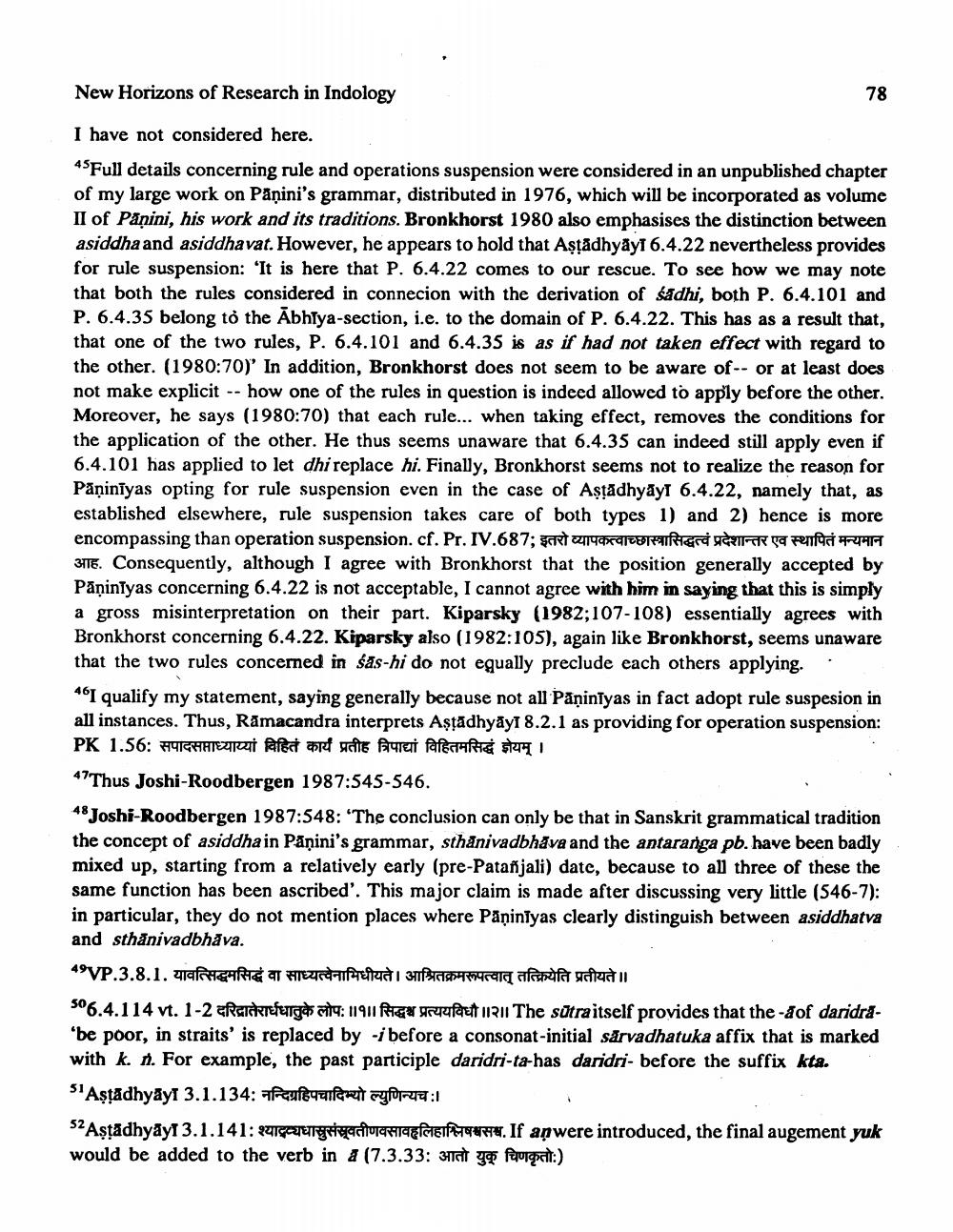________________
New Horizons of Research in Indology
78
I have not considered here. 4SFull details concerning rule and operations suspension were considered in an unpublished chapter of my large work on Panini's grammar, distributed in 1976, which will be incorporated as volume II of Panini, his work and its traditions. Bronkhorst 1980 also emphasises the distinction between asiddha and asiddhavat. However, he appears to hold that Aşțădhyāyt 6.4.22 nevertheless provides for rule suspension: 'It is here that P. 6.4.22 comes to our rescue. To see how we may note that both the rules considered in connecion with the derivation of sadhi, both P. 6.4.101 and P. 6.4.35 belong to the Abhiya-section, i.e. to the domain of P. 6.4.22. This has as a result that, that one of the two rules, P. 6.4.101 and 6.4.35 is as if had not taken effect with regard to the other. (1980:70)' In addition, Bronkhorst does not seem to be aware of -- or at least does not make explicit -- how one of the rules in question is indeed allowed to apply before the other. Moreover, he says (1980:70) that each rule... when taking effect, removes the conditions for the application of the other. He thus seems unaware that 6.4.35 can indeed still apply even if 6.4.101 has applied to let dhi replace hi. Finally, Bronkhorst seems not to realize the reason for Pāņinīyas opting for rule suspension even in the case of Așțădhyāyt 6.4.22, namely that, as established elsewhere, rule suspension takes care of both types 1) and 2) hence is more encompassing than operation suspension. cf. Pr. IV.687; $ct 2114 | Braire Ropa pe RH 3116. Consequently, although I agree with Bronkhorst that the position generally accepted by Pāņiniyas concerning 6.4.22 is not acceptable, I cannot agree with him in saying that this is simply a gross misinterpretation on their part. Kiparsky (1982;107-108) essentially agrees with Bronkhorst concerning 6.4.22. Kiparsky also (1982:105), again like Bronkhorst, seems unaware that the two rules concerned in śas-hi do not equally preclude each others applying.. 461 qualify my statement, saying generally because not all Pāṇiniyas in fact adopt rule suspesion in all instances. Thus, Rāmacandra interprets Așțădhyāyi 8.2.1 as providing for operation suspension: PK 1.56: #4CHHEZIT Rafect or weite Anrei fast start 47Thus Joshi-Roodbergen 1987:545-546. 48 Joshi-Roodbergen 1987:548: 'The conclusion can only be that in Sanskrit grammatical tradition the concept of asiddhain Pāņini's grammar, sthånivadbhava and the antaranga pb. have been badly mixed up, starting from a relatively early (pre-Patanjali) date, because to all three of these the same function has been ascribed'. This major claim is made after discussing very little (546-7): in particular, they do not mention places where Pāņinīyas clearly distinguish between asiddhatva and sthànivadbhāva. 49VP.3.8.1. qrafieHRIST AT HTEZIfrated, 3 rei afonifa wetu 506.4.114 vt. 1-2 Ratkrefurgos ats: 11911 Peuruulautail The sūtraitself provides that the -dof daridra'be poor, in straits' is replaced by i before a consonat-initial sarvadhatuka affix that is marked with k. . For example, the past participle daridri-ta-has daridri- before the suffix kta. STAşțădhyay 3.1.134: afrafeefeat ayforrera:1 52Aştadhyāyt 3.1.141: Quarga anturasraamwerk . If aņwere introduced, the final augement yuk would be added to the verb in a (7.3.33: 316 yo furpat:)




